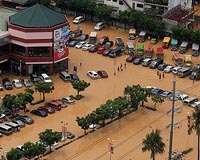| . |  |
. |
Troy NY (SPX) Nov 18, 2009 A dangerous level of carbon dioxide and methane gas haunts Lake Kivu, the freshwater lake system bordering Rwanda and the Republic of Congo. Scientists can't say for sure if the volatile mixture at the bottom of the lake will remain still for another 1,000 years or someday explode without warning. In a region prone to volcanic and seismic activity, the fragility of Lake Kivu is a serious matter. Compounding the precarious situation is the presence of approximately 2 million people, many of them refugees, living along the north end of the lake. An international group of researchers will meet Jan. 13-15 in Gisenyi, Rwanda, to grapple with the problem of Lake Kivu. A grant from the National Science Foundation won by Rochester Institute of Technology will fund the travel and lodging for 18 scientists from the United States to attend the three-day workshop. Anthony Vodacek, conference organizer and associate professor at RIT's Chester F. Carlson Center for Imaging Science, is working closely with the Rwandan Ministry of Education to organize the meeting. "Rwandan universities suffered greatly in the 1994 genocide and there are few Rwandan scientists performing significant work on the lake or within the rift system," Vodacek notes. "We will work with the government to identify interested researchers." Vodacek is convening the workshop with Cindy Ebinger, an expert in East African Rift tectonics at the University of Rochester, and Robert Hecky, an expert in limnology-the study of lake systems-at University of Minnesota-Duluth. Core samples Hecky took in the 1970s initially brought the safety of Lake Kivu under question. Addressing the lake as a whole system is a new concept for the workshop participants, who will bring their expertise in volcanology, tectonics and limnology to the problem. Vodacek's goal is to prioritize research activities and improve communication between the North American, European and African collaborators. "Most scientists are fairly in agreement that the lake is pretty stable; it's not as if its going to come bursting out tomorrow," Vodacek says. "But in such a tectonically and volcanically active area, you can't tell what's going to happen." One of the problems with Lake Kivu is that the 1,600-foot deep lake never breathes. The tropical climate helps stagnate the layers of the lake, which never mix or turn over. In contrast, fluctuating temperatures in colder climates help circulate lake water and prevent gas build up. Lake Kivu is different from both temperate and other tropical lakes because warm saline springs, arising from ground water percolating through the hot fractured lava and ash, further stabilize the lake. Scientists at the workshop will consider how these spring inputs may vary over time under changing climates and volcanic activity. A number of catalysts could destabilize the gas resting at the bottom of Lake Kivu. It could be an earthquake, a volcanic explosion, a landslide or even the methane mining that has recently united Rwandan and Congolese interests. Close calls occurred in 2008 when an earthquake occurred near the lake and in 2002 when a volcanic eruption destroyed parts of Goma in the Democratic Republic of Congo, only 11 miles north of Lake Kivu. Although scientists were alarmed, neither event sufficiently disturbed the gas. Vodacek likens the contained pressure in the lake to a bottle of carbonated soda or champagne. "In the lake, you have the carbon dioxide on the bottom and 300 meters of water on top of that, which is the cap," he says. "That's the pressure that holds it. The gas is dissolved in water." When the cap is removed, bubbles form and rise to the surface. More bubbles form and create a column that drags the water and the gas up to the surface in a chain reaction. "The question is, and what's really unknown, is how explosive is that?" Vodacek says. Through his own research Vodacek plans to simulate the circulation of Lake Kivu. Modeling the circulation patterns above the layers of carbon dioxide and methane will help determine the energy required to disrupt the gas and cause Lake Kivu to explode. Share This Article With Planet Earth
Related Links Rochester Institute of Technology Bringing Order To A World Of Disasters A world of storm and tempest When the Earth Quakes
 Philippine floods spur move to high-rises: industry
Philippine floods spur move to high-rises: industryManila (AFP) Nov 17, 2009 High-rise living has suddenly become more popular in Manila after killer storms caused massive flooding in the Philippine capital, property industry officials said here Tuesday. Businesses are also moving to higher ground to avoid a repeat of the devastation from recent storms, which killed more than 1,100 people in Manila and other parts of the island of Luzon, the officials told a business ... read more |
|
| The content herein, unless otherwise known to be public domain, are Copyright 1995-2009 - SpaceDaily. AFP and UPI Wire Stories are copyright Agence France-Presse and United Press International. ESA Portal Reports are copyright European Space Agency. All NASA sourced material is public domain. Additional copyrights may apply in whole or part to other bona fide parties. Advertising does not imply endorsement,agreement or approval of any opinions, statements or information provided by SpaceDaily on any Web page published or hosted by SpaceDaily. Privacy Statement |